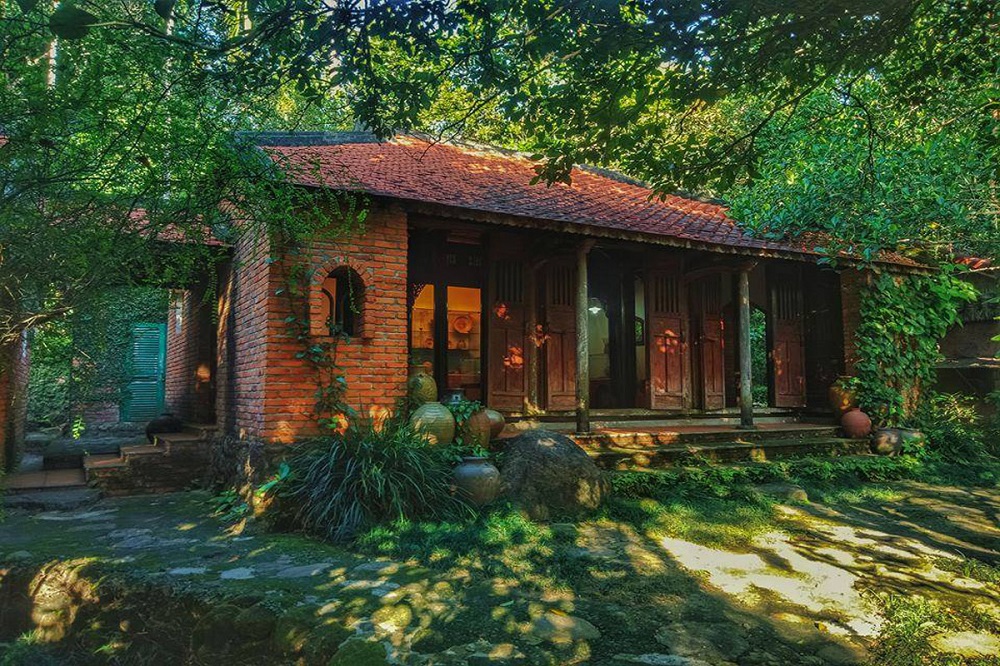Vitality of private museums in Da Nang
In the flow of cultural heritage conservation, the contribution of many individuals through activities of collecting, preserving antiques as well as developing private museums is indispensable. Investment in private museums does not focus on economic benefits but helps bring great cultural and spiritual values to the whole community.
 |
| Ancient houses nestled among rows of green trees are the highlight of the Dong Dinh Museum. Photo: KHANH HOA |
How to develop private museums, helping to spread beautiful values is a tough task for both managers and investors.
Interesting and unique features
Come to the Dong Dinh Museum, located on Hoang Sa Street in Son Tra District, Da Nang, to learn about the thinking of forming and managing such a private museum with cultural depth, worthy of the title ‘the first private museum in Da Nang;.
Located on a hill, nestled in the nature of the mountains and forests, the Dong Dinh Museum’s collections of artifacts on display are rich in preserving ancient cultural values. Amidst the cool green space, close to nature, the peaceful scenery of the museum evokes the feeling of a garden of old memories.
According to Ho Ngoc Quynh Tram, the Manager of Dong Dinh Museum, the museum is named after a tree species - ‘Dong Dinh’ that’s belongs to areca catechu growing mainly in the Son Tra forest area, a highlight of the ecological landscape here.
There are small, winding paths paved with cobblestones of different sizes. Interspersed under the shady tree canopies are ancient houses with hundreds of antiques collected by the owner from many regions of Viet Nam, carefully preserved and maintained, including jars and ancient pottery.
Through Tram's sharing, in order to renew and increase its attractiveness, the museum has recently completed the construction of afternoon tea rooms. Tea is taken from many famous tea growing regions across Viet Nam and prepared through the skillful hands of tea artisan invited from Hoi An to serve guests. The number of visitors to the museum is growing day by day thanks to this new product.
Located close to the city’s centre, but with the owner's thinking and sophistication in design, the Dong Dinh Museum still retains the pure features of a building interspersed among nature and mountains.
Located in the Quan The Am Pagoda, the Buddhist Cultural Museum is considered the first ever of its kind in Viet Nam, currently displaying more than 500 ancient Buddhist artifacts, many of which reflect the Buddhist art of Viet Nam and many other Asian countries.
The birth of the Buddhist Cultural Museum has created a unique tourist highlight, becoming an attractive new site for visitors during their Da Nang trips.
Developing private museums - not just anyone's business
In the flow of preserving the cultural heritage, the contributions of many individuals through activities of collecting, preserving antiques as well as developing private museums are indispensable.
The valuable thing is that most museums were established on base of private collections. When establishing private museums, individuals almost never put business goals first, but rather want to contribute to preserving historical memories and cultural beauty of the country.
Although privately invested, there are many large museums with a large number of valuable artifacts that can be on par with public ones. Notable among them are such as the Buddhist Cultural Museum and the Non Nuoc Stone Sculpture Museum.
There are museums that charge very little fees, for instance an entrance fee of only VND 30,000/person at the Dong Dinh Museum. Meanwhile, there are museums that are completely free for visitors with the sole purpose of spreading beautiful values.
However, along with their passion for heritage, they also always hope that love will not be eroded by the heavy burden of making a living. Therefore, in addition to their own efforts, reasonable support from State management agencies, as well as a smooth legal corridor, is an extremely important issue. And many museums that want to develop long-term are still struggling with the problem of how to develop.
According to Quynh Tram, one of the effective directions for museums, and private ones in particular, is to link with tourism to find new ways that are both unique and spread good values, while attracting visitors and commercialising them to maintain long-term sustainability.
Throughout history, museums have always been a place where historical and artistic heritages converge. They are places to preserve, collect and synthesise heritage values for display, convey historical information, national identity and patriotism spirit to the general public.
Private museums also undertake many good tasks such as stimulating tourism, solving employment, creating a beautiful tourist attraction for each land, leaving a good impression in the hearts of tourists near and far... Because of these values, there is a need for more support and encouragement to create more quality private museums.
According to Mr. Ha Vy, the Deputy Director of the Da Nang Department of Culture and Sports, identifying the non-public museum system as one of the important cultural institutions indispensable in social life, in recent years, Da Nang has organised many activities to create conditions for the establishment of the private museum system, improving the quality of activities such as bringing museums into a list of travel venues in tour packages, supporting professional and technical activities and making brochures introducing museums. This aims to contribute to preserving and promoting the value of national cultural heritage and serving the increasingly growing cultural enjoyment needs of people and tourists.
Reporting by KHANH HOA - Translating by A.THU








